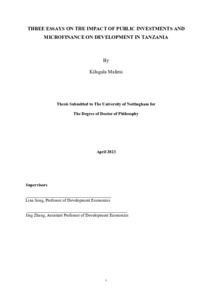Malimi, Kilugala
(2023)
Three essays on the impact of public investments and microfinance on development in Tanzania.
PhD thesis, University of Nottingham.
![This thesis has been corrected for minor cosmetic corrections in Chapter 2 (Table 4) and Chapter 3 (Table 5). The corrections involves restricting the digits in these tables to two decimal places. I have also appended comparative variations (Table A6). [thumbnail of This thesis has been corrected for minor cosmetic corrections in Chapter 2 (Table 4) and Chapter 3 (Table 5). The corrections involves restricting the digits in these tables to two decimal places. I have also appended comparative variations (Table A6).]](https://eprints.nottingham.ac.uk/73528/1.hassmallThumbnailVersion/MALIMI%20Kilugala_14342288_PhD%20Thesis.pdf)  Preview |
PDF (This thesis has been corrected for minor cosmetic corrections in Chapter 2 (Table 4) and Chapter 3 (Table 5). The corrections involves restricting the digits in these tables to two decimal places. I have also appended comparative variations (Table A6).)
(Thesis - as examined)
- Requires a PDF viewer such as GSview, Xpdf or Adobe Acrobat Reader
Available under Licence Creative Commons Attribution.
Download (1MB)
| Preview
|
Abstract
This study examined the effects of public investments and microfinance on development in Tanzania. The study focused on three aspects of development, namely, farm labour productivity, poverty reduction, and child mortality reduction. The study used three waves of panel data from the National Panel Survey in Tanzania collected between 2008 and 2013. The study presented three papers presented in the three final chapters of this report: Chapter 2, 3, and 4.
Chapter 2 estimated the effects of public investments in agricultural input subsidies (AIS) and Agricultural extension services (AES) on farm labour productivity. Estimates in Chapter 2 show that both AIS and AES are effective in raising farm labour productivity among farmers involved in maize production. Moreover, the two programmes are also effective in raising land productivity. Further estimates in Chapter 2 show that both AIS and AES have comparable effects on labour productivity and land productivity. Chapter 3 estimates and compared the effects of AIS and microfinance on poverty reduction among maize and rice farmers in Tanzania. Using control function and instrumental variable approaches to control for the endogeneity of the two programmes, estimates in Chapter 3 show that AIS and microfinance are effective in reducing poverty among farmers involved in maize and rice production. Moreover, estimates in Chapter 3 show that both programmes have comparable effects on household consumption, indicating that they have equal poverty reduction effects.
Lastly, Chapter 4 estimated the effects of subsidized insecticide-treated nets (ITNs) and free medicare on malaria-caused child mortality in Tanzania. This chapter used residual inclusion to estimate the survival model and found that while subsidized ITNs are effective in reducing the hazard associated with malaria-caused child mortality, the use of free medicare in malaria treatment was not effective in reducing child mortality. However, when deaths from all diseases are considered, both subsidized ITNs and free medicare are significantly effective. This suggests that while free medicare is not effective in reducing malaria-caused mortality, it is, however, effective in reducing overall child mortality. Moreover, when the effects of the two programmes are compared, both programmes have comparable effects against malaria-caused child mortality. However, when deaths from all diseases are considered, the effect of subsidized ITNs is significantly bigger than that of free medicare. This suggests that in reducing overall mortality, the use of subsidized ITNs reduces more child mortality than the use of free medicare alone.
| Item Type: |
Thesis (University of Nottingham only)
(PhD)
|
| Supervisors: |
Song, Lina
Zhang, Jing |
| Keywords: |
Agricultural input subsidy, agricultural extension services, farm labour productivity, microfinance, rural poverty reduction, subsidized insecticide-treated nets, free medicare, child mortality, Tanzania |
| Subjects: |
H Social sciences > HD Industries. Land use. Labor
H Social sciences > HG Finance
R Medicine > RA Public aspects of medicine |
| Faculties/Schools: |
UK Campuses > Faculty of Social Sciences, Law and Education > Nottingham University Business School |
| Item ID: |
73528 |
| Depositing User: |
Malimi, Kilugala
|
| Date Deposited: |
24 Jul 2023 04:40 |
| Last Modified: |
28 Feb 2025 15:17 |
| URI: |
https://eprints.nottingham.ac.uk/id/eprint/73528 |
Actions (Archive Staff Only)
 |
Edit View |

 Tools
Tools Tools
Tools